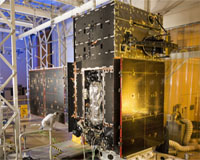 |
Paris (ESA) May 05, 2011 Recognising the value of using Earth observation satellite data to support development activities, ESA and the World Bank will work together on several projects through the 'eoworld' joint initiative. ESA and the World Bank first started collaborating two years ago when ESA carried out small-scale pilot projects that demonstrated the potential of Earth observation for the Bank's operations. Based on the pilots' promising outcomes, Earth observation information will now be scaled up and incorporated into 12 World Bank activities in the marine environment, water resources management, urban development, urban and disaster risk management, and agriculture and forestry. The breadth of applications of Earth observation services shows the value of these services as useful tools to World Bank teams in the planning, implementation, monitoring and assessment of their ongoing and future projects," said Anthony Bigio, senior urban specialist at the World Bank and coordinator of the eoworld initiative. "The ultimate goal of these services is to help the World Bank offer better informed advice to our client partners." World Bank teams defined the requirements for the geo-information that will be provided across operations in Africa, South and Latin America, South Asia, East Asia and the Pacific. The Earth observation information products will be generated by specialist companies from across Europe and delivered to the Bank's staff and local stakeholders by the end of 2011. A two-day event took place in April at World Bank headquarters in Washington, DC, that brought ESA, the World Bank and Earth observation information companies together to get the projects started. "The main aim of the eoworld initiative is to demonstrate the value of European and Canadian satellites, both ESA and national missions, and the capabilities of specialised value-adding companies that can provide information services to benefit the World Bank's operations," said Stephen Coulson, ESA's Head of Industry Section.
Expanding collaboration The session featured presentations from the International Charter for Space and Major Disasters, an initiative set up by ESA and the French space agency, CNES, to provide satellite data to rescue workers in the event of natural or man-made disasters. The activities of the Global Facility for Disaster Reduction and Recovery (GFDRR) were also highlighted. The Bank manages the GFDDR to help developing countries reduce their vulnerability to natural hazards and adapt to climate change. Following discussions, ESA and GFDDR identified new possibilities for collaboration, including World Bank disaster risk management teams participating in an ESA event in May 2012 that focuses on Earth observation satellites and geo-hazard risks.
Share This Article With Planet Earth
Related Links Earth Observation Market Development Space Technology News - Applications and Research
 U.S. Air Force Poised To Launch First-Of-Its-Kind Space Based Infrared System Satellite
U.S. Air Force Poised To Launch First-Of-Its-Kind Space Based Infrared System SatelliteCape Canaveral AFS FL (SPX) May 05, 2011 The first Space Based Infrared System (SBIRS) geosynchronous (GEO-1) satellite stands at Cape Canaveral Air Force Station, Fla., prior to being mated with the launch vehicle in preparation for its May 6 blastoff. The U.S. Air Force and Lockheed Martin are ready to launch the first Space Based Infrared System (SBIRS) geosynchronous (GEO-1) spacecraft on Friday, May 6 aboard a United Launch ... read more |
|
| The content herein, unless otherwise known to be public domain, are Copyright 1995-2010 - SpaceDaily. AFP and UPI Wire Stories are copyright Agence France-Presse and United Press International. ESA Portal Reports are copyright European Space Agency. All NASA sourced material is public domain. Additional copyrights may apply in whole or part to other bona fide parties. Advertising does not imply endorsement,agreement or approval of any opinions, statements or information provided by SpaceDaily on any Web page published or hosted by SpaceDaily. Privacy Statement |